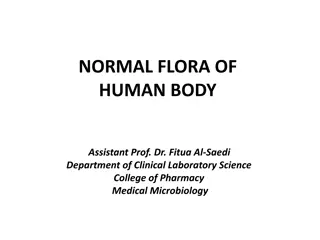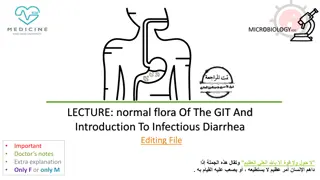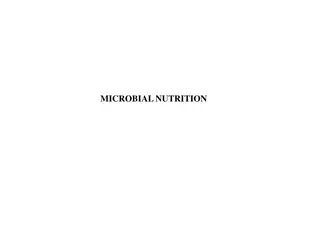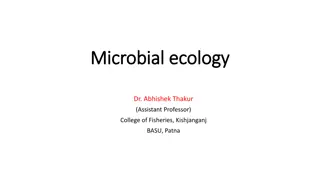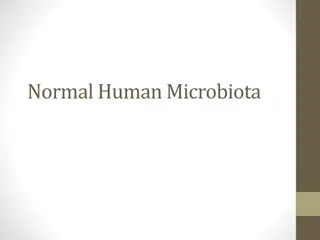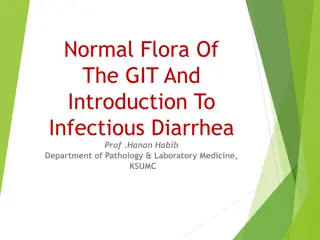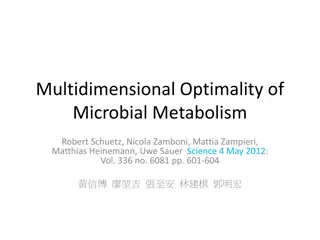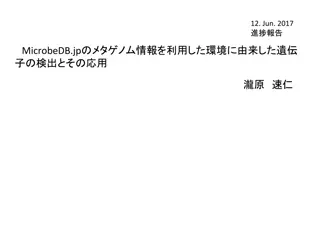Understanding the Normal Microbial Flora of the Human Body
The normal microbial flora, also known as the indigenous microbiota, inhabit various areas of the human body such as the gastrointestinal tract, respiratory tract, genitourinary tract, and skin. They play a crucial role in maintaining health and can re-establish themselves when disturbed. While resident flora are lifelong members, transient flora temporarily reside on body surfaces. Factors influencing the microbial flora include local conditions, nutrient availability, immune status, and anatomical site. The composition mainly consists of bacteria and some fungi, with anaerobes outnumbering aerobes. Specific bacteria populate sites like the gastrointestinal tract, with Bacteroides fragilis and Escherichia coli being common. Understanding the microbiology of normal flora is essential for comprehending human health and disease.
Download Presentation

Please find below an Image/Link to download the presentation.
The content on the website is provided AS IS for your information and personal use only. It may not be sold, licensed, or shared on other websites without obtaining consent from the author. Download presentation by click this link. If you encounter any issues during the download, it is possible that the publisher has removed the file from their server.
E N D
Presentation Transcript
Normal Microbial Flora of Human Body
Normal flora Also called indigenous microbiota Diverse group of microbial population that every human being harbors on his/her skin and mucous membranes Sites - gastrointestinal tract (GIT), respiratory tract, genitourinary tract & skin
Normal Flora Resident Flora Life-long members of the body s normal microbial community Closely associated with a particular area, when disturbed re-establish themselves Do not cause harm; rather can be beneficil
Transient Flora Microorganisms that inhabit the body surface or mucous membranes temporarily for a short interval Many are potential pathogens, e.g. pneumococcus and meningococcus in nasopharynx Can be easily eliminated by following proper hand hygiene and other infection control practices In hospitals, patients may acquire resistant organisms as transient flora from the healthcare workers and hospital environment - MRSA in nose and skin
MICRO BIOLOGY OF NORMAL FLORA Almost constant for an area of the body at a given age Normal flora acquired soon after birth and persist till death Their presence depends upon: - Local temperature, moisture, pH - Presence of certain nutrients and inhibitory substances - Environmental flora - Immune status of the individual - Anatomical site: Skin or mucosa
Composition: Predominantly bacteria & some fungi Total population of normal flora - about 1014 bacteria; which is more than total number of cells (1013) present in human body Anaerobes > aerobes Anaerobic/aerobic bacteria varies depending upon the body site
GIT - predominant site Commonest normal flora - Bacteroides fragilis; among aerobes - Escherichia coli
Neisseria (non-pathogenic species) Diphtheroids, Staphylococcus epidermidis pneumococci, Staphylococcus aureus, Gram-negative rods, Yeasts Fusobacterium Less predominant- GIT Predominant- 0 105 Stomach 1:1 Lactobacillus Helicobacter pylori Enterobacteriaceae and other Gram-negative rods, Enterococci, Streptococci ( and non hemolytic) 104 107 Jejunum/ileum 1:1 Anaerobic cocci Bacteroides fragilis Fusobacterium Bifidobacterium Prevotella Clostridium Diphtheroids Candida albicans and other yeasts 1011 1012 103:1 Terminal ileum & colon Staphylococcus aureus Less predominant- Female genital tract Predominant- Corynebacterium species, Lactobacillus species, Streptococci ( and non hemolytic) Neisseria (non-pathogenic species) Enterococci, Enterobacteriaceae & other Gram-negative rods, S.epidermidis, Candida albicans and other yeasts 107 109 Vagina 10:1 Anaerobic cocci Lactobacillus Prevotella Bifidobacterium Clostridium Skin Less predominant- Predominant- Propionibacterium Staphylococcus epidermidis Staphylococcus aureus , Candida species, 3:2 Anaerobic cocci 102 103
Beneficial Effects of Normal Flora Prevent colonization of pathogen: compete for attachment sites or for essential nutrients Synthesize vitamin: Vitamin K and B complex Waste produced antagonize other bacteria: - Fatty acids and peroxides - Lactic acid: Lactobacilli in vagina of adult females maintain acidic pH - Bacteriocin: antibiotic-like substances that can inhibit or kill other bacteria
Beneficial Effects of Normal Flora Immune stimulation Development of lymphatic tissues: e.g. Peyer s patches in intestine Stimulate antibody production: that cross-react with pathogens having related or shared antigens and prevent their entry Complement activation: endotoxins liberated by the gram-negative normal flora trigger alternative complement pathway
Beneficial Effects of Normal Flora Prevent allergic diseases (Hygiene hypothesis): - Lack of early childhood exposure to symbiotic microorganisms (e.g. gut flora or probiotics), infectious agents and parasites increases susceptibility of the individual to allergic diseases by suppressing the natural development of the immune system
Disturbed Normal Flora Promote Infection Mechanisms by which the normal flora is disturbed: Injudicious use of broad spectrum antimicrobial agent: suppress the normal flora & permit pathogen to take the upper hand and cause infection - Clostridioides difficile causing pseudomembranous colitis Host factors - immune suppression, reduced peristalsis promote pathogen to grow Physical destruction of the normal flora: irradiations, chemicals, burns
Disturbed Normal Flora Promote Infection Inoculum size of entering pathogen is high then it can dominate over the normal flora Minor trauma in mouth (e.g. by dental procedure, chewing or vigorous brushing) entry of small numbers of bacteria (e.g. viridians streptococci) transiently into bloodstream bacterial endocarditis
Harmful Effects of Normal Flora May be agents of disease: endogenous disease When the host immunity is lowered e.g. Gram negative organisms colonizing the respiratory tract pneumonia Entry into wrong site or tissue (e.g. blood, sterile body cavities) disease (E.coli, intestinal commensal UTI) Transfer to susceptible hosts: pathogens that colonize the upper respiratory tract (meningococcus, pneumococcus) can produce disease in susceptible hosts
Harmful Effects of Normal Flora Bacterial synergism: Bacterial vitamins and growth factors may promote the growth of the potential pathogens Contribute to the drug resistance of pathogens: normal flora produce enzymes such as beta lactamases which destroy the beta lactam antibiotics Competition for host nutrients
Diseases produced by Normal Flora Diseases produced by normal flora Anatomical site from which the flora is transferred Urogenital infections including UTI E.coli, Klebsiella, Proteus Endocarditis Oral flora (Streptococcus viridans) Dental caries and periodontal disease Peritonitis, abdominal infection Oral flora (Streptococcus mutans) Intestinal flora Pneumonia Transient respiratory flora
Probiotics Definition: As live microorganisms (part of normal flora) which, when administered in adequate amounts, confer a health benefit to the host Indication: when normal intestinal flora is suppressed Commercially available probiotics contain: - Bacillus coagulans - Bifidobacterium longum - Lactobacillus acidophilus - Saccharomyces boulardii
Uses of Probiotics - Gastroenteritis due to any cause - Antibiotic-associated diarrhea - Lactose intolerance - Irritable bowel syndrome and colitis - Necrotizing enterocolitis - Helicobacter pylori infection - Reducing serum cholesterol level by breaking down bile in the gut, thus inhibiting its reabsorption
Uses of Probiotics - Reducing blood pressure (by producing ACE inhibitor-like peptides during fermentation) - Immune function restoration and preventing infections - Modulate inflammatory and hypersensitivity responses - Bacterial vaginosis - restoring the acid pH of vagina by lactic acid producing bacteria
Prebiotics Dietary nondigestible fibers which when administered, stimulate the growth and activity of commensal microorganisms and thereby exert beneficiary effect to the host indirectly
REFRENCES Text Book Of Medical Microbiology by Ananth Narayan Paniker Text Book Of Medical Microbiology by D R Arora Text Book Of Medical Microbiology by A S Sastry Text Book Of Medical Microbiology by Baweja Text Book Of Medical Microbiology by Satish Gupte



